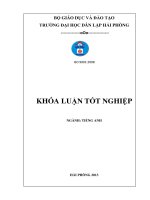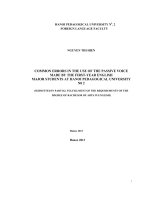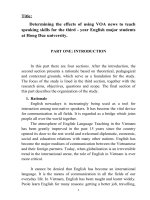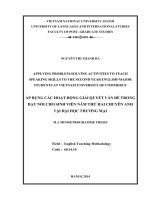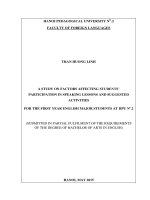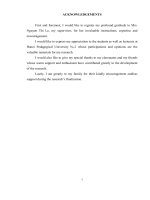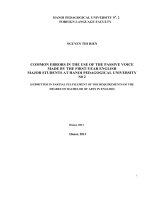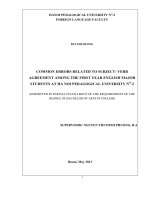Common errors in the use of the subjunctive mood among the third year english major students at HPU2 and suggested solutions
Bạn đang xem bản rút gọn của tài liệu. Xem và tải ngay bản đầy đủ của tài liệu tại đây (438.53 KB, 54 trang )
i
HANOI PEDAGOGICAL UNIVERSITY N
0
2
FOREIGN LANGUAGE FACULTY
TRIEU THI PHUONG
COMMON ERRORS IN THE USE OF THE
SUBJUNCTIVE MOOD AMONG THE THIRD-YEAR
ENGLISH MAJOR STUDENTS AT HPU2 AND
SUGGESTED SOLUTIONS
(GRADUATION PAPER SUBMITTED IN PARTIAL FULFILLMENT OF THE
DEGREE OF BACHELOR OF ARTS IN ENGLISH)
Supervisors: Ms. Emily Parenteau
Mr. nguyen Van Den, M.A.
HA NOI, 2015
ii
ACKNOWLEDGEMENTS
I would like to take this opportunity to express my deep gratitude to my
supervisors, Ms. Emily Parenteau and Mr. Nguyen Van Den, M.A., for their patience
in providing continuous and careful guidance as well as encouragement, indispensable
suggestions and advice. Without their help and valuable comments on the content as
well as the organization of the study, it would be far from accomplished.
My sincere thanks also extended to teachers and students in the K38 class of the
Foreign Language Faculty at Hanoi Pedagogical University N
o
2 for their cooperation
and for their help during my survey process. The teachers‟ permission along with the
students‟ support helped me collect the necessary and sufficient data for the survey.
Last but not least, I would like to thank my family and my friends for helping and
encouraging me throughout my research.
iii
ABSTRACT
The subjunctive mood is an interesting category of English grammar. It is used to
express something that is not true, a statement contrary to fact. Although it is
somewhat rare, questions concerning the subjunctive are very often featured on
English language certification exams. However, constructions using the subjunctive
are not very easy to recognize and they often cause confusion and embarrassment for
learners of English.
Students of English often make errors when they use the subjunctive mood.
Thus, this research entails studying the types and uses of the subjunctive mood and
conducting a survey for error analysis.
The types of errors and their causes have been found from the results of the
survey. In addition, the researcher suggests some solutions for those problems.
iv
STATEMENT OF AUTHORSHIP
Title:
Common Errors in the Use of the Subjunctive Mood among the Third-Year
English Major Students at Hanoi Pedagogical University N
o
2
and Suggested Solutions
I certify that no part of this report has been copied or reproduced by me from any
other person‟s work without acknowledgements and that the report is originally
written by me under strict guidance from my supervisors.
Date submitted: May 2015
Student Supervisors
Trieu Thi Phuong Ms. Emily Parenteau
Mr. Nguyen Van Den, M.A.
v
ABBRIVIATIONS
FLF : Foreign Language Faculty
HPU2 : Hanoi Pedagogical University Number 2
p. : Page number
ed. : Edition
2
nd
ed. : Second Edition
3
rd
ed. : Third Edition
4
th
ed. : Fourth Edition
8
th
ed. : Eight Edition
vi
TABLE OF CONTENTS
ACKNOWLEDGEMENTS i
ABSTRACT iii
STATEMENT OF AUTHORSHIP iv
PART ONE: INTRODUCTION
I. RATIONALE 1
II. RESEARCH PRESUPPOSITION 2
III. RESEARCH OBJECTIVES 3
IV. RESEARCH SCOPE 3
V. RESEARCH METHODS 3
VI. RESEARCH TASKS 3
VII. RESEARCH SIGNIFICANCE 3
VIII. DESIGN OF THE RESEARCH 4
PART TWO: DEVELOPMENT
CHAPTER ONE – THEORETICAL BACKGROUND
I.1. Literature Review in Brief 5
I.2. Concept of Mood in English 8
I.2.1. Definitions of Mood 8
I.2.2. Classification of Mood 8
I.2.2.1.The Indicative Mood 8
I.2.2.2. The Subjunctive Mood 8
I.2.2.3. The Imperative Mood 9
I.3. An Overview of the Subjunctive 9
I.3.1. Definitions of the Subjunctive Mood 9
I.3.2. Classification and Form of the Subjunctive 10
I.3.2.1. The Present Subjunctive 10
I.3.2.2. The Past Subjunctive 11
I.3.3. Use of the Subjunctive Mood 11
I.3.3.1. The Mandative Subjunctive 11
I.3.3.2. The Formulaic Subjunctive 12
vii
I.3.3.3. The Past Subjunctive with “Would Rather…That” 13
I.3.3.4.The Past Subjunctive in Unreal Conditional Sentences 13
I.3.3.5. The Past Subjunctive in “Wish” Sentences 15
I.3.3.6. The Past Subjunctive with “As If/As Though” 15
I.3.3.7. The Past Subjunctive with “If Only” and “It is (High) Time” 16
I.3.4. Patterns of the Subjunctive 18
I.3.4.1. Compound Forms 18
I.3.4.2. “Should” as Subjunctive 18
CHAPTER TWO
COMMON ERRORS IN THE USE OF THE SUBJUNCTIVE
II.1. SURVEY 20
II.1.1. Purpose of the Survey 20
II.1.2. Population of the Survey 21
II.1.3. Type of the Survey 21
II.1.4. Construction of the Test 21
II.1.5. Preparation of the Survey 22
II.1.5.1. Test Items 22
II.1.5.2. Arrangement of Test Items 22
II.1.6. Administration of the Survey 23
II.1.6.1. Preparation of the Survey 23
II.1.6.2. Delivery of the Survey 23
II.1.7. Methods of Data Analysis 24
II.1.8. Results of the Survey 24
II.2. COMMON ERRORS AND CAUSES 26
II.2.1. Errors in the Form of the Verb “to be” in the Mandative Subjunctive 26
II.2.2. Errors in the Use of the Subjunctive in Reported Speech 27
II.2.3. Errors in the Verbs‟ Form of the Formulaic Subjunctive 27
II.2.4. Errors in the Use of the Past Subjunctive with “As If” and “As Though” 28
II.2.5. Errors in Verb Form for the Third Person Singular in the Mandative
Subjunctive 28
II.2.6. Errors in making negative form of the Subjunctive 29
II.2.7. Errors in the Use of the Past Subjunctive with “If only” 29
viii
II.2.8. Errors in the Use of the Past Subjunctive in “Wish” sentences 29
II.2.9. Errors in the Form of the Verb “to be” in the Past Subjunctive 30
II.2.10. Errors in the Use of the Past Subjunctive with “Would rather/sooner” 30
II.2.11. Errors in the Use of the Past Subjunctive in Conditional sentences 30
II.2.12. Errors in the Use of the Past Subjunctive with “It‟s (high) time” 31
II.3. Suggested Solutions and Exercises 32
II.3.1. Suggested Solutions 32
II.3.2. Suggested Exercises 33
PART THREE - CONCLUSION
III.1. Summary of the Research 35
III.2. Limitations and Suggestions for Further Study 36
III.2.1. Limitations 36
III.2.2. Suggestions for Further Study 36
`REFERENCES 37
APPENDIX 39
1
PART ONE: INTRODUCTION
I. RATIONALE
The development of science and modern technology along with the integration
and socio-economic globalization trends has brought about a great demand for
intercommunication. As a result, English has become an international language which
is popularly used in almost every aspect of life and almost all economic sectors. It has
become a bridge among countries and is considered a means of communication
creating mutual understanding among people around the world. Up to now, English
has been regarded as a second language of many countries in general and an official
language of international organizations in particular. According to the article titled The
History of English (2011) stated that 85 percent of international organizations have
English as at least one of their official languages, about one third of international
organizations (including OPEC, EFTA and ASEAN) use English only and this figure
rises to almost 90 percent among Asian international organizations.
In Vietnam, as in many Asian nations, English plays an important role. Learning
English has become more prevalent and to be seen as more necessary for than ever
before. English is taught as one of the core subjects in many levels of education.
Vietnamese students are made aware of the importance and necessity of studying
English to meet the increasingly important social and economic demand. However,
mastering the English language is not a simple thing. Learners of English encounter a
great variety of difficulties in acquiring not only grammatical rules but also language
skills due to the learners‟ mother tongue interference and oftentimes significant
cultural factors. Grammar is an extremely important part of learning English. Crystal
(2004) states:
Grammar is the structural foundation of our ability to express ourselves. The more we
are aware of how it works, the more we can monitor the meaning and effectiveness of
the way we and others use language. It can help foster precision, detect ambiguity, and
exploit the richness of expression available in English. (p.26)
However, when compared with other languages, English is seen to have a
complicated grammar system. It often causes embarrassment and confusion for
students, especially in communication. It is obviously true that the difficulties in using
grammar might considerably interfere with students practicing English language skills.
2
Among multiple categories of English grammar, one of the most challenging
grammatical categories can be the subjunctive mood. In present-day English, the
subjunctive mood is not used as often as it was in old-English. However, it still exits in
modern formal English (Glencoe, 2002, p.39) and often appears in examinations for
recognized English language certifications. To use it correctly and effectively is a
challenge for many students, especially those in Vietnam. In modern English, the
subjunctive form of a verb is, in many cases, the same as a
corresponding indicative form. This means that the subjunctive is not a very visible
grammatical feature of English. For most verbs, the only distinct subjunctive form is
found in the third person singular of the present tense, where the subjunctive lacks
the -s ending. As a consequence of this quality of indistinctness, students often have
difficulties in mastering the subjunctive mood thoroughly.
The analysis of students‟ errors plays a significant role in English teaching and
learning. It helps teachers identify students‟ strategies of language learning and their
level of proficiency, so that teachers can then find out suitable ways to improve current
situations. It also helps students understand fundamental mistakes and have a better
overall picture of the subjunctive mood.
For the reasons above, this study was conducted with the aim of focusing on
errors in using the subjunctive mood among third-year English major students at Hanoi
Pedagogical University Number 2 (HPU2) and suggesting some solutions.
II. RESEARCH PRESUPPOSITION
With regard to suggesting some solutions for common errors in using the
subjunctive mood, the following questions are raised:
- What kinds of errors in the subjunctive mood are made by third-year English
major students at HPU2?
- What percentage of the errors do these account for?
- Which error made by third-year English major students is the most common?
- What are the causes of the errors in using the subjunctive mood made by
third-year English major students at HPU2?
- What are some effective ways of minimizing the errors that English major
students at HPU2 commonly make?
3
III. RESEARCH OBJECTIVES
The study is aimed at the following goals:
- To find out the common types of errors in the use of the subjunctive mood
made by third-year English major students at HPU2
- To find what is causing the third-year English major students to make these
errors
- To offer some suggestions to minimize errors in using the subjunctive mood
IV. RESEARCH SCOPE
The general research area of this study is Grammar. The phenomena are the
errors in the use of the subjunctive mood made by the English major students of the
Foreign Language Faculty (FLF). Other topics relating to the subjunctive mood are
also briefly mentioned.
The population involved in the study was one hundred students in class K38
(including 64 students in the Bachelor of Arts program and 36 students in the Bachelor
of Pedagogy program) of the FLF at HPU2 in the academic year of 2014-2015.
V. RESEARCH METHODS
With a view to finding out the common errors as well as the possible solutions
for these errors in using the subjunctive mood, all local and foreign documents will be
collected and reviewed. A survey is designed and conducted. After they have been
collected, the results will be analyzed and their possible solutions will be explained.
VI. RESEARCH TASKS
The study involves fulfilling the following tasks:
- To study the definition, form, classification and uses of the subjunctive mood
in English
- To conduct a survey to find out error types and causes related to the
subjunctive mood in English
- To suggest some solutions which could help to minimize the students‟ errors
VII. RESEARCH SIGNIFICANCE
To many students of English, making mistakes in using English grammar in
general as well as the subjunctive mood in particular is unavoidable due to its
complexity. However, using the proper methods, it might be possible to minimize the
errors. Thus, it is hoped that the study will help to provide:
4
- A full and clear understanding of the subjunctive mood
- Ways to assist students in minimizing the common types of errors
- A useful reference on the issue of the subjunctive mood in English for both
teachers and students with the aim of ensuring a deep and clear understanding
of all related aspects
VIII. DESIGN OF THE RESEARCH
The research is divided into three main parts: Introduction, Development and
Conclusion.
Part One gives reasons for choosing the topic, objectives, and methods as well as
the significance of the study. It also narrows the scope of the study and briefly presents
an overall outline of the research.
Part Two consists of two chapters. Chapter One is called Theoretical
Background, which first presents the literature review in brief and a general overview
of mood in English including its definition and classification. This is followed by a
specific overview of the subjunctive mood. The subjunctive mood is presented in
detail including its definition, form, classification, and uses. Some special patterns of
the subjunctive are also examined. Chapter Two is about common errors in the use of
the subjunctive mood including three sections. The first section describes specifically
the research methodology which relates to the survey, a description of subjects, the
survey construction, preparation of the survey, and the methods of data analysis. It is
the most important section in the entire the research. The second section deals with
common errors in the use of the subjunctive mood and their causes. The last one
suggests some solutions and exercises to minimize these errors.
Part Three summarizes the contents of the research, points out limitations of the
research and gives some suggestions for further study.
5
PART TWO: DEVELOPMENT
CHAPTER ONE – THEORETICAL BACKGROUND
I.1. Literature Review in Brief
In general, the constructions of the subjunctive mood are relatively numerous and
quite difficult to recognize and distinguish. Up to now, a large number of grammarians
have been interested in this grammatical feature, notably including Quirk and
Greenbaum (1973), Thomson and Martinet (1986), Azar (1989), Doan Minh and
Nguyen Thi Tuyet (2001), Richard (2002), Vince (2003), and Murphy (2012), to name
a very few. Almost all of these authors focus their attention on the verb forms of the
subjunctive, its classification, and uses.
In the book A University Grammar of English, Quirk and Greenbaum (1973) give
information about mood in English. They indicate three distinguishable categories of
the subjunctive: the mandative subjunctive, the formulaic subjunctive, and the
subjunctive “were”. They also explain in detail the verb forms and the usage of each
category.
In A Practical English Grammar (4
th
ed.), Thomson and Martinet (1986) focus
on the verb forms and uses of the present and past subjunctive (or unreal past) mood.
They also show in detail some constructions of the subjunctive with “would rather”
and “would sooner”; “It is (high) time”; the conjunctions “as if” and “as though”; and
the subjunctive in conditional and “wish” sentences. They also include an analysis of
the use of unreal past tenses in indirect speech and notes when using these
constructions of the subjunctive mood.
In his book entitled Essentials of English Grammar: A Practical Guide to the
Mastery of English (2
nd
ed.), Baugh (1987) also conducts her research on the three
types of mood. After conveying the usage of mood, she indicates specific functions of
the indicative, the imperative, and the subjunctive mood. She states that the
subjunctive mood uses a different form of the present and the past to express matters
of urgency, formality, possibility, and speculation. Additionally, she also indicates the
different between the subjunctive and the indicative mood. The subjunctive is used to
express something that is not true, a statement contrary to fact, while the indicative
simply states a fact.
6
Azar (1989) studied the use of the subjunctive in noun clause in his book entitled
Understanding and Using English Grammar. He discusses some common verbs and
expressions which are followed by the subjunctive in a noun clause, such as insist, ask,
advise, request, recommend, suggest, demand, it is necessary/important/vital/essential/
advisable/imperative that, and many of the subjunctive‟s other uses. He also discusses
the formation of negative and passive sentences in the subjunctive mood.
Collins and Hollo (2000) are unlike many other grammarians in the way they
conduct their research on clause type and mood. In their book entitled English
Grammar: An Introduction, they mainly emphasize six forms of the subjunctive mood:
counterfactual, imperative, necessity, proposition, supposition, and wish. Each form
has its own use and function.
Doan Minh and Nguyen Thi Tuyet (2001) further the study of mood in their book
named English Grammar for Advanced Students. They firstly define the concept of
mood: “Mood refers to the sort of attitude the speaker has when he says the sentence”.
Next, they briefly introduce its classification including three kinds of mood: the
indicative, the imperative, and the subjunctive. Then, they specifically focus on the
subjunctive mood, its types, and uses. Like Thomson and Martinet, they also explain
the uses of two types of the subjunctive mood. They go on to talk about the uses of
“wish”, “if only”, “would rather/sooner”, and “it is (high) time” in the subjunctive
mood. In addition, to help learners have a clear understanding of the subjunctive
mood, the difference between the present and the future tense of the unreal condition is
also drawn out. They say that the present and future tense of unreal conditional
sentences share the same form; the difference is the adverbial modifier of time. They
also add that unreal past tense does not change in indirect speech.
In An Introduction to Old English, Richard (2002) deals with the usages of the
subjunctive mood in Old English and present-day English. He shows when the
subjunctive mood is used, how it works and which usages in Old English still remain
in present-day English. This historical perspective is important to a well-rounded
understanding of the subjunctive mood, and informs much of the background for
current research.
7
Vince (2003) focuses his attention on unreal time and subjunctives in his book
entitled Advanced Language Practice. He gives explanations for the uses of some
constructions with the subjunctive, such as “it is (high) time”, “wishes”, “would
rather” (followed by a clause), and “as if/though”. He also explains the uses and verb
forms of formal subjunctives and mentions some fixed expressions using subjunctives,
which is called formal subjunctives. In formal subjunctives, he says that after verbs
such as demand, insist, suggest, and require, the subjunctive may be used in formal
style. This has only the infinitive form; there is no third person singular –s or past
tense form.
In English Grammar in Use (4
th
ed.), Murphy (2012) deals with the subjunctive
mood in terms of the conjunctions as if/as though, structures with would rather and it is
time, the uses of wish and conditional sentences. He also gives explanations for the use
of “should” after noun clauses, such as when using It is essential/
vital/necessary/important, etc that and after the number of verbs and adjectives like
insist, recommend, suggest, surprise, strange, and others.
In his speech at a TED conference titled Grammar, Identity, and the Dark Side of
the Subjunctive, the scholar Phuc Tran (2012) firstly introduces the importance of
studying the subjunctive. He states:
Grammar is a tool to be used like a pair of glasses. And when it‟s used at the right time,
it can bring the world into sharp focus. And when it‟s used at the wrong time, it can
make things incredibly blurry. And this all starts with our understanding of the
subjunctive.
Then, he indicates the dark side of the use of the subjunctive mood is that the
subjunctive allows us to be creative, but it also allows us to become mired in regret.
Meanwhile, the indicative does not allow us to imagine, however, it does allow us to
talk about ourselves and our experience in real terms. Finally, he mentions the way
that grammar affects culture. He shows a finding that Viet Nam is the most optimistic
country in the world. In his opinion, this is because it is a country whose language
does not naturally have the subjunctive and does not encourage its speakers to obsess
over the idea of “could have been”.
In short, each grammarian mentioned has made a certain contribution to the study
of the subjunctive mood. Most of the knowledge they offer is extremely useful for
students. However, none of these grammarians deal with errors that students most
8
frequently make when using the subjunctive mood. Therefore, it is necessary to have a
detailed description of students‟ errors in using the subjunctive and then to find
effective ways of minimizing these mistakes. It is to this aim that the research will be
conducted.
I.2. Concept of Mood in English
I.2.1. Definitions of Mood
A large number of definitions of mood have been given in many grammar books
and dictionaries. While these definitions are not always identical, many of them have
some features in common. In English Grammar for Advanced Students, Doan and
Nguyen put it quite simply: “Mood refers to the sort of attitude the speaker has when
he says the sentence” (2001, p.37). In the Oxford Advanced Learner’s Dictionary (8
th
ed.), mood is defined as “any of the sets of verb forms that show whether what is said
or written is certain, possible, necessary, etc. or one of the categories of verb use that
expresses facts, orders, questions, wishes or conditions” (2010). According to Quirk
and Greenbaum in A University Grammar of English: “Mood relates the verbal action
to such conditions as certainty, obligation, necessity or possibility; the expression of
the future is closely bound up with mood” (1973, p.40). In short, mood is the form of
the verb that shows the mode or manner in which a thought is expressed or an action is
represented.
I.2.2. Classification of Mood
There are three moods in English: the indicative mood, the subjunctive mood,
and the imperative mood (Baugh, 1987).
I.2.2.1.The Indicative Mood
A sentence has a verb in the indicative mood when it declares its contents or asks
its question directly without expressions of attitude.
Examples: He speaks English fluently.
Will you come to my party tomorrow?
Most English verbs are in the indicative (Doan & Nguyen, 2001).
I.2.2.2. The Subjunctive Mood
A sentence has a verb in the subjunctive mood when it expresses a hypothetical
or doubtful situation, or something contrary to fact. As in the following example:
If I were you, I would stay at home.
9
(In this example, the speaker is giving advice based on the impossibility that he
or she was the listener. Therefore, this sentence is hypothetical)
I.2.2.3. The Imperative Mood
A sentence has its verb in the imperative mood when it is used for giving orders,
commands, instructions, or requests.
For instances:
Go outside! (This is a command)
Please close the window! (This sentence expresses a request)
In the imperative mood, “you” is understood before the verb. With the first and
second person, we use the construction with “let”.
Examples: Let me be!
Let‟s go camping!
I.3. An Overview of the Subjunctive
I.3.1. Definitions of the Subjunctive Mood
According to Baugh, “the subjunctive mood uses a different form of the past and
present to express matters of urgency, formality, possibility, or speculation” (1987).
For example:
- Urgency: I demanded that she see me immediately.
(In the regular form of the verb, it would be conjugated as „she sees.‟ However,
the speaker here wishes to express urgency, which is one function of the subjunctive
mood, thus the construction changes to „she see.‟)
- Formality: He recommended that the zoning law be adopted.
(The speaker is referring to laws and is likely speaking in a formal setting.
Normally, the construction would be “the zoning law is adopted,” but as the speaker
must express formality, they will use the subjunctive form “the zoning law be
adopted”.)
- Possibility: If he were to come, I would not be like this.
(This sentence expresses a future possibility. It has no reference to the past, even
though “were” is a past tense verb form.)
- Speculation: If I were president, I would decree that smoking be banned.
10
(In this sentence, the speaker expresses a hypothetical situation that he is
president. However, in fact, he is not president so he cannot decree that smoking
should be banned.)
The subjunctive mood is different from the indicative mood in that it expresses
something that is not true, a statement contrary to fact, while the indicative mood
simply states a fact. In its GMAT Ultimate Grammar, the GMAT Club notes: “The
subjunctive is used to indicate that one person wants another person to do something”
(2011, p.168). According to the Oxford Advanced Learner Dictionary (8
th
ed.), the
subjunctive is defined as the form or mood of a verb that expresses wishes, possibility,
or uncertainty (2010).
For example: I wish I were taller.
(In this sentence above, the speaker expresses a wish that is contrary to fact that; he is
not taller, so were is a subjunctive verb form.)
In short, subjunctive verb forms are rarely used in present-day English and
subjunctive verbs are invariable. They do not exhibit subject-verb concord as in the
following example:
I suggested that he see a doctor.
(Normally, the form of “to see” that is used for “he” is “sees”. However, as
subjunctive-verb concord is not exhibited by subjunctive verbs, “see” is used for “he”
in this sentence.)
I.3.2. Classification and Form of the Subjunctive
In English, the subjunctive mood is classified as the present or the past
subjunctive (Thomson & Martinet, 1986).
I.3.2.1. The Present Subjunctive
The present subjunctive has exactly the same form as the infinitive, therefore the
present subjunctive of “to be” is “be” for all persons, and the present subjunctive of all
other verbs is the same as the present tense. However, “s” is not added for the third
person singular. As in the following examples:
The Queen lives here. (simple present tense)
Long live the Queen! (present subjunctive tense)
11
I.3.2.2. The Past Subjunctive
The past subjunctive has exactly the same form as the simple past. However, the
past subjunctive form of the verb “be” is either I/he/she/it was or I/he/she/it were. In
expressions of doubt or unreality, “were” is more common than “was”.
Example: He behaves as though he were the owner.
(This sentence expresses an unreality. In fact, he is not the owner)
I.3.3. Use of the Subjunctive Mood
I.3.3.1. The Mandative Subjunctive
The mandative subjunctive in that-clauses has only the base form; this means
that there is no s-ending of the finite verb in the third person singular, or past form.
The verb “be” is “be” for all persons.
This subjunctive can be used with any verb in subordinate that-clauses when the
main clause contains an expression of recommendation, resolution, demand, or related
ideas.
Below are some common verbs that are often followed by the subjunctive in that-
clauses:
demand suggest insist move
recommend request advise desire
ask propose require urge
Examples: I insist that he leave now.
The teacher demanded that we be on time.
The present subjunctive is also used in that-clauses following adjectives of
urgency such as advisable, vital, desirable, important, necessary, urgent, and
essential. These statements are similar to commands, but they are impersonal and
therefore softer (2009, p.128).
Examples: It is necessary that everybody know this issue.
It is advisable that he have a balanced diet.
There are a few items that are important to note when discussing this issue. The
first is that the present subjunctive can be used after nouns that are corresponding to
these verbs, including but not limited to suggestions, recommendations, and proposals.
Examples: My recommendation is that we be on time.
My proposal is that his resignation be accepted.
12
To make the negative form, the speaker must put “not” before verbs in the clause after
“that”, as in:
I insist that he not leave now.
The teacher suggests that we not be noisy.
I.3.3.2. The Formulaic Subjunctive
The formulaic subjunctive also consists of the base form of the verb, but it is
only used in clauses in certain set expressions which have to be learned as wholes.
They are used to express a wish or hope and often involve supernatural powers.
For example: Come what may
God save the Queen!
Heaven forbid that
God bless you!
This is also found in the phrase “if need be”, which means “if it is necessary”.
Example: We can always bring another umbrella, if need be.
(This sentence implies that if it is necessary, the speaker and the other referents
of “we” have the option to bring another umbrella.)
Ha (1993, p.268) stated that a wish can be expressed using the formula:
May + S + bare infinitive
Examples: May you be happy in all your life.
May my grandfather live a long life.
I.3.3.3. The Past Subjunctive with “Would Rather…That”
This form of the subjunctive expresses actions contrary to fact at the present.
Would rather is followed by past form of the verb, as wishes about the present and the
verb “to be” is conjugated as “were” for all persons. It expresses preference about
actions, and can be expressed using the formula:
S1 + would rather that + S2 + verb [in simple past tense]
For examples:
I would rather that he paid cash.
(In fact, he doesn‟t pay or doesn‟t plan to pay cash.)
I would rather that it were summer now.
(In fact, it is not summer now.)
13
It can also be used for expressing actions contrary to fact in the past. Would
rather can be followed by the past perfect form of the verb to express wishes about the
past, using the formula:
S1 + would rather that + S2 + past perfect
For example:
Tom would rather that Jill had gone to school yesterday.
(In fact, Jill didn‟t go to school yesterday.)
The following items are important to note:
That is allowed to be omitted in some forms of the subjunctive with would rather
in modern grammar. Many writers opt to omit it in favor of concision or brevity.
To make negative forms, did not and were not are used after the second subject.
For example: I would rather that he didn‟t come.
One can use would sooner interchangeably with would rather, there is no
different between the sentiments they express.
I.3.3.4.The Past Subjunctive in Unreal Conditional Sentences
The unreal conditional is used to convey a situation that would take place, or
would have taken place, if the circumstances were, or had been, different. It can refer
to past, present, or future situations.
a. The Past Subjunctive in the Second Conditional
This form is created using the formula:
If + S + V_simple past tense + would/could/might+ V_simple form
Conditional type two is used when the supposition is contrary to known facts. It
is also used when one does not expect the action in the if-clause to occur.
Examples:
I would go to the concert if it were possible.
This sentence is untrue because I know that I cannot go to the concert.
If a stranger followed me at night, I would run as fast as possible.
(But I do not expect a stranger to follow me at night.)
Thomson & Martinet state: “The past tense in the if clause of conditional
sentences type two is not a true past but a subjunctive, which indicates unreality or
improbability in the present or future” (1986, p.198).
Examples:
14
If I had a car, I would lend it to you.
(But I don‟t have a car. The meaning here is in the present.)
If someone tried to break into my house, I would tell the police.
(The meaning here is the hypothetical future, because currently there is
no one trying to break into my house.)
b. The Past Subjunctive in the Third Conditional
The past subjunctive in the third conditional is expressed using the following
formula:
If + S + V_past perfect + would/could/might+ have + V_past participle
The subjunctive in the third conditionals indicates unreality or improbability in
the past.
For example: If Rob hadn‟t gone to the party, he wouldn‟t have lost his job.
(In reality, Rob went to the party and he lost his job.)
When using this form, it is important to note that:
The if clause can also come at the beginning of the sentence without changing the
meaning. However, when the if clause begins the sentence, a comma is used to
separate it from the main clause.
Example:
I could go to the ball game if I didn‟t have to work.
OR If I didn‟t have to work, I could go to the ball game.
In the unreal condition, the past tense form of the verb “be” is always “were”. It
can never be “was.”
If the verb in the unreal conditional sentence is positive, the meaning is actually
negative. If the verb is negative, the meaning is actually positive.
For examples:
If he were taller, he could play professional basketball.
(He is not tall, he cannot play professional basketball.)
I could record an album if I were a better singer.
(I cannot record an album; I am not a better singer.)
If the taxi driver hadn‟t been speeding, he wouldn‟t have been in an accident.
(The taxi driver was speeding. He was in an accident.)
They would have received tickets if they hadn‟t been late.
15
(They didn‟t receive tickets. They were late.)
I.3.3.5. The Past Subjunctive in “Wish” Sentences
The verb wish indicates something that definitely did not happen or will not
happen. It is never followed by a present tense verb or an auxiliary verb. It is important
to keep in mind that a wish construction is very similar to a contrary to fact or unreal
condition. The formula:
Wish (that) + S + V_past tense
This construction expresses regret and unreal conditions in the present. For instance:
I wish I were famous.
(In fact, I am not famous.)
The following formula is used to express regret about a past situation.
Wish (that) + S + V_past perfect
For instance:
I wish they had arrived earlier.
(But, they didn‟t arrive earlier.)
The following should be noted:
The word “that” can be added or omitted, the sentence is correct either way
and that is a stylistic option.
“Wished” can replace “wish” without changing the subjunctive.
Example: I wished I hadn‟t spent too much money.
(I did send too much money.)
These verbs in “wish” sentences will be reported unchanged:
Example: “I wish I took his advice,” she said.
She said she wished she took his advice.
I.3.3.6. The Past Subjunctive with “As If/As Though”
Sentences using as if and as though are similar to conditional sentences in that
they indicate something that is unreal or contrary to fact. Like “wish” sentences, the
verb following these conjunctions must be in the past or past perfect tense. The past
tense of the verb “be” must always be “were” and never be “was” in a contrary to fact
sentence. These sentences are expressed using the formula:
S + verb + as if/as though+ S + verb in past
16
Note that this construction is used to indicate unreality, improbability, or doubt in
the present.
Examples:
That boy acts as if he were stupid, but he really is smart.
(The boy is not stupid.)
Aaron drives as though he were a racecar driver.
(Aaron is not a racecar driver.)
The past perfect form is expressed through the formula:
S + verb + as if/as though+ S + verb in past perfect
The past perfect is used after as if/as though when the sentence refers to an
unreal or imaginary action in the past.
Examples:
Barry told the story as if he had been there.
(Barry was not there.)
The prisoner looked as if he had won the case.
(He had not won the case.)
Note: The verb preceding “as if/as though” can be put into a past tense without
changing the tense of the subjunctive, for example:
He talked as if he were my father.
(In fact, he is not my father.)
I.3.3.7. The Past Subjunctive with “If Only” and “It is (High) Time”
If only can be used in the same way and with the same meaning as “wish”, but it
is more indirect. As such, it is stronger and more unrealistic than “wish”. It is used in
conversation and in formal writing (1986, p.52). The formulas for these expressions
are explained below:
If only + V_simple past: If only followed by a verb in the past tense
expresses a regret or wish for something that is unreal in the present, for
instance:
If only there were snow in summer.
(But there is not snow in summer.)
If only he would take the exam.
(In fact, he will not take the exam.)
17
If only + V_past perfect: If only followed by a verb in the past perfect
expresses a regret, or a wish that something had happened differently in the
past, for instance:
If only he had come to the party.
(He did not come to the party)
If only I had taken his advice.
(I did not take his advice)
It‟s (high) time + S + V_simple past tense: expresses that something should
be done and that it is already a bit late.
For example:
It's time you went to bed. You'll have to get up early tomorrow.
(You need to go to bed now, and you should have gone to bed earlier.)
It's high time I bought a new pair of jeans.
(I need to buy a new pairs of jeans, and I should have bought them
earlier.)
There are a few notes on this section:
The word “high” can be used or not used in these sentences. “High” adds
slightly more emphasis to the feeling that something should be started
immediately and should have been started sooner. (1986, p.182)
When “it‟s (high) time” is followed by I/she/he/it, it cannot then be
followed by “were”: (1986, p.182)
Example: It‟s time I was leaving.
Unreal tenses after wish, if only, would rather/would sooner, it's (high)
time and as if/as though do not change in indirect speech.
For example:
Susan: I wish I lived in the mountains.
Susan said she wished she lived in the mountains.
Charles: If only we hadn't missed the train.
Charles said that if only they hadn‟t missed the train.
